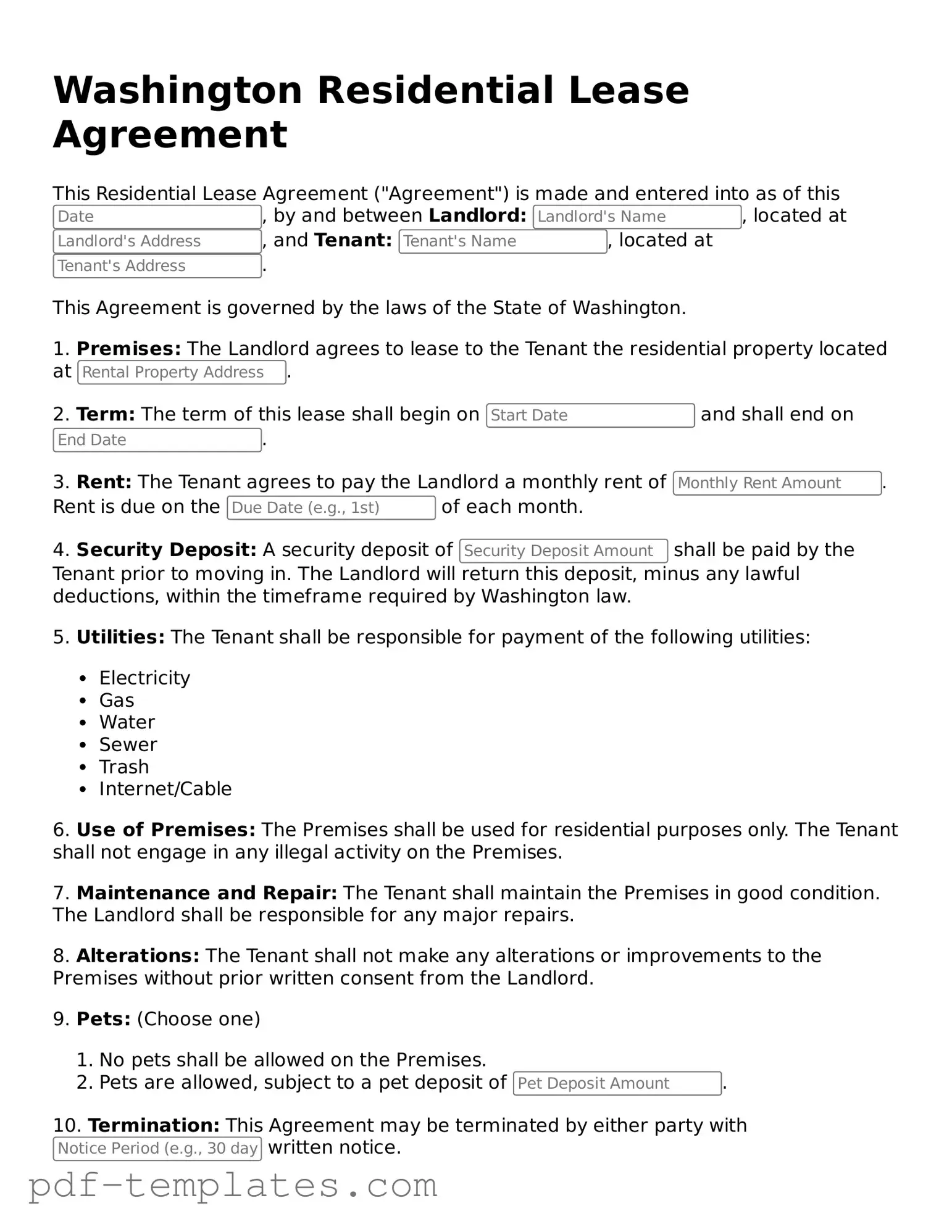The Washington Residential Lease Agreement is similar to the Rental Agreement, which is often used for shorter-term arrangements. Both documents outline the terms under which a tenant can occupy a property. They specify details such as the rental amount, duration of the lease, and responsibilities of both parties. While a residential lease typically covers a longer period, a rental agreement may be more flexible, allowing for month-to-month terms. This makes the rental agreement ideal for those who need short-term housing solutions.
Another document similar to the Washington Residential Lease Agreement is the Commercial Lease Agreement. This type of lease is used for business properties rather than residential ones. Like the residential lease, it includes terms regarding rent, duration, and maintenance responsibilities. However, commercial leases often contain additional clauses related to business operations, such as permitted uses of the space and compliance with zoning laws. Both agreements serve to protect the interests of landlords and tenants, but they cater to different types of properties.
In the realm of rental agreements, ensuring that all necessary forms are correctly filled out is essential for both landlords and tenants. This is particularly true in California, where specific documents govern the relationships and responsibilities between parties. For those looking for all the required documentation, All California Forms can be a valuable resource, encompassing various agreements tailored to different rental situations while maintaining clarity and legal compliance.
The Sublease Agreement is another document that shares similarities with the Washington Residential Lease Agreement. This agreement allows a tenant to rent out their leased space to another individual, known as the subtenant. Both documents outline the responsibilities of the parties involved, including payment terms and property maintenance. However, the original tenant remains responsible to the landlord for the lease terms, creating a unique dynamic in the relationship. This document is particularly useful for tenants who need to temporarily vacate their rental unit.
The Lease Option Agreement also bears resemblance to the Washington Residential Lease Agreement. This document provides a tenant the option to purchase the property at a later date. It includes many of the same terms found in a standard lease, such as rental payments and maintenance duties. However, it also includes specific provisions regarding the purchase price and the time frame in which the tenant can exercise their option. This agreement can benefit both parties, as it gives tenants a path to homeownership while providing landlords with a potential buyer.
The Month-to-Month Rental Agreement is another document that aligns closely with the Washington Residential Lease Agreement. This type of agreement allows tenants to occupy a property on a month-to-month basis, providing flexibility for both parties. Like the residential lease, it includes rental payment terms and responsibilities for property maintenance. However, it typically requires a shorter notice period for termination, making it suitable for those who may not want to commit to a long-term lease.
The Roommate Agreement is similar in that it outlines the responsibilities and expectations of multiple tenants sharing a rental unit. This document covers aspects such as rent payment, utility responsibilities, and house rules. While the Washington Residential Lease Agreement is between the landlord and a single tenant, a roommate agreement is created among tenants to ensure everyone is on the same page. This can help prevent misunderstandings and conflicts in shared living situations.
The Lease Purchase Agreement is another document that is akin to the Washington Residential Lease Agreement. This agreement combines elements of a lease and a purchase contract, allowing tenants to rent a property with the intention of buying it later. Similar to the lease agreement, it outlines rental terms, but it also includes conditions related to the eventual purchase, such as price and financing. This type of agreement can be beneficial for tenants who want to secure a home while having the flexibility to rent initially.
Finally, the Eviction Notice is related to the Washington Residential Lease Agreement in that it can arise from a breach of the lease terms. While the lease agreement outlines the rights and responsibilities of both parties, the eviction notice serves as a formal communication from the landlord to the tenant regarding lease violations. This document details the reasons for eviction and the timeline for vacating the property. Understanding both documents is crucial for tenants and landlords alike, as it helps clarify the consequences of not adhering to the lease terms.
